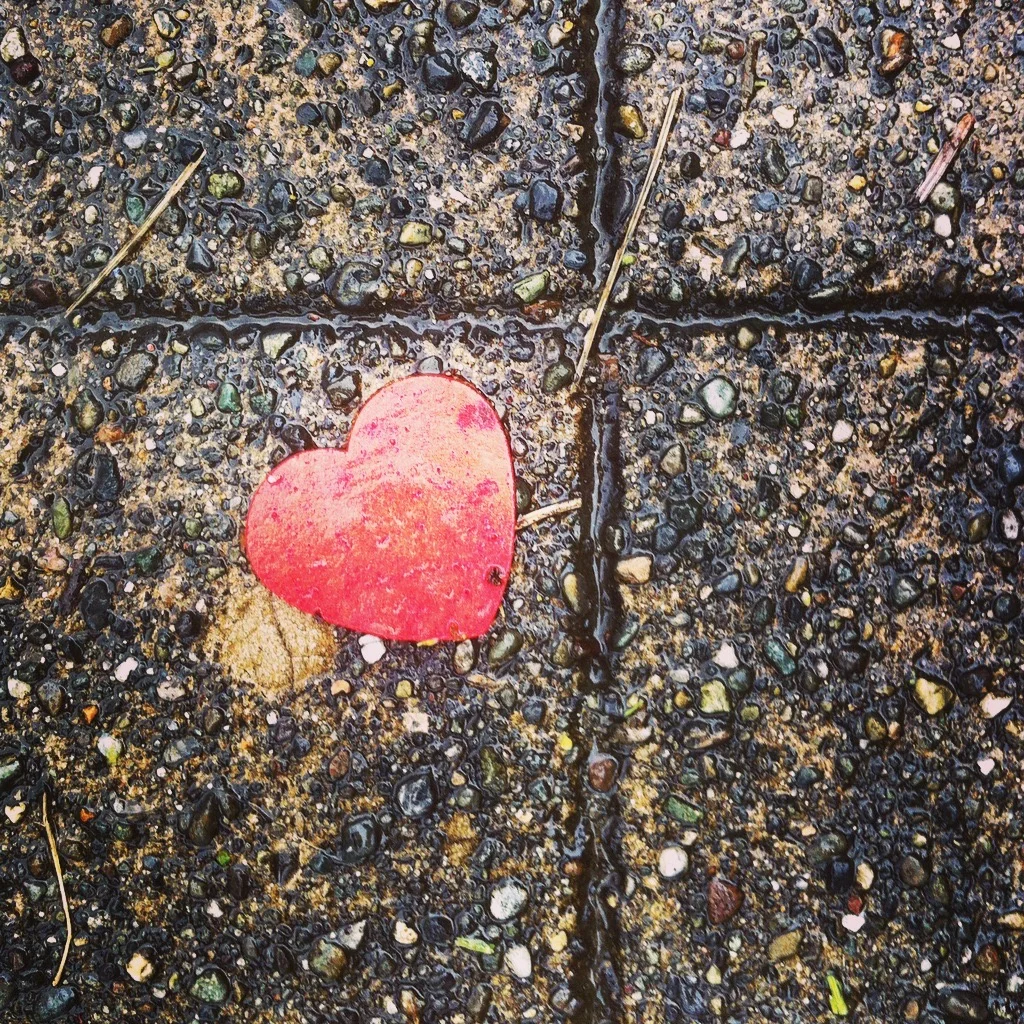On rainy day in March 2015, I walked outside of my apartment in Capitol Hill and noticed the heart pictured above on the sidewalk. This wasn’t a terribly groundbreaking moment. Having worked for science museums, I’d been trying to slow down and notice the world around me for some time. But, for some reason, I decided to snap a photo of it and posted it to Instagram with a hashtag I made up on the spot, #seattleloves. I felt something positive in noticing that heart. I associated it with the idea that I belonged in Seattle, having only arrived a few days before. For several months after, I posted dozens of pictures of hearts. A patch of bare dirt, a cloud, a broken hazelnut shell, graffitti. I began to notice hearts everywhere.
I documented each photo dutifully with #seattleloves until my relationship with Instagram got “complicated” and I removed the app to regain some of my attention. By that point, though, the practice of noticing hearts was a habit. I continued to notice them, and still snapped photos occasionally. Four years passed. Noticing a heart had become an experience of orientation, like a signpost on a trail telling me I was on the right path.
Then, a few months ago, when I had some extra time and it was a lovely day, I decided to walk from the ferry terminal downtown to the university. I chose to walk over Capitol Hill and I found myself a few blocks away from where my practice began. I noticed a heart. This one:
At that moment, on that day, with that heart, I realized these hearts weren’t signposts so much as reminders that I everywhere I am is the right place.
A Contemplative Practice
When I tell people that I research contemplative practice, they more often than not reply, “What do you mean by contemplative practice?” Much of what I mean can be illustrated by this example of noticing hearts. But before I can speak to that, I should center us on at least one understanding of the word contemplation.
Contemplation is a moment of presence to life. It can have mundane and/or extraordinary consequences (extraordinarily joyful or painful) or someplace in between. It does not require practice, in fact, we all experience contemplation from time to time. As Mary Frohlich, a Religious of Sacred Heart and professor, describes it:
We can define contemplative experience as awareness—whether fleeting or habitual—of that most foundational, most original depth of being. … Because this is our most foundational reality, contemplative experience is potentially available to every human being, at all times and in every circumstance. It can and does “happen” to people without any preparation and while they are engaged in pursuits that are not concerned with seeking it.
In my noticing hearts example, contemplation occurred in the moment of truth I experienced when I noticed the green graffitied heart on the sidewalk. Contemplative practice, the four years worth of hearts I noticed prior to that moment, readied me for that moment. It also made that moment available to me because I was attuned to the act of noticing instead of being caught up in my thoughts of the future or past (which is almost certainly where I’d be otherwise).
The practice cultivated a purposeful curiosity—a habitual preoccupation with the mysterious unfolding of my own life—that resonated deep within me. The realization that “everywhere I am is the right place” changes my perspective and behavior (when I can remember it), and invites me to accept what life gives and to have compassion for myself and others when what life gives is particularly challenging. I’ve found (and still find) the practice to be delightfully rewarding, life giving, and of deep comfort.
I also realize the truths this practice holds for me are still unfolding. I do not know what I might take from noticing hearts in the years to come. That, too, I hold with curiosity and commitment.
An Invitation to Practice
In the Design Methods class I’m teaching this fall, I will be inviting my students to establish their own noticing practice. This is, in part, to help them become better designers. But it’s also, in part, to invite them to explore the mysteries in their own life with a similar purposeful curiosity. After mentioning the assignment to a colleague, who then began to notice hearts herself, I decided to share this blog post and invite anyone to engage in the practice. Here is the Google Slides template if you would like to use that on your own, or in your classroom.
I should also say that don’t have to notice hearts, of course. Any shape, object, or concept that regularly hides in plain sight will do. For prior students hearts, circles, feathers, specific colors (or gradients of color), or concepts like pareidolia have worked well. My advice is to pick what resonates most for you, and adjust if you never see it, or it doesn’t delight you when you do.





